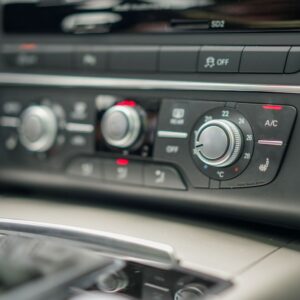Most modern vehicles are equipped with automatic climate control systems that allow you to input a specific target temperature and set a specific blower speed. HVAC systems can even control the temperature of specific parts of a cabin, allowing each passenger to set the temperature that meets their preferences. You’ll also notice an auto button in your climate control settings that has a corresponding light that turns on and off when pressed. What does the auto button mean in your car’s A/C controls? We’ll discuss what this button does and when you should press it.
What Does the Auto Button Do In Your Car’s A/C?
The auto button activates the HVAC system’s auto setting, which optimizes various HVAC settings such as the blower’s fan speed, recirculation setting, and air direction so that the cabin reaches and maintains your set temperature.
Think of it as a closed loop system like the central heat and air in your home or apartment. When you set the desired temperature, it can command compressor operation, air temperature (controlled with the blend door), fan speed, etc. It uses in-car temperature to decide what needs to be done to reach the desired temperature.
Control Blower Fan Speed
Blower fan speed is the HVAC system’s fan that draws air from outside the car (NORM) or inside the car (MAX/Recirc), then moves that air through the evaporator out into the passenger compartment through the vents on the dash called “the register.” If warm air is needed, the blend door moves to allow air through the heater core to enter the plenum to mix with the dehumidified air from the evaporator.
Increasing blower fan speed for more cold or hot air is an effective way of getting the cabin to the target temperature faster, but if the A/C’s refrigerant is low or the compressor won’t engage, there’s only so much the fan can do. Sensors will detect your cabin temperature and engage the compressor and operate the blend door one way or another to increase cooling or heating depending on its current temperature. Again, this a feedback loop type system.
You’ll notice that activating the auto setting will change the blower setting to a setting that the system deems appropriate to reach your desired temperature faster. If your vehicle’s cabin is incredibly hot or cold, the climate control will set the blower to its maximum setting to try to speed up the cooling or heating process. The auto mode will also turn down the blower fan speed once the HVAC system has reached your target temperature.
Control Recirculation Setting
The recirculation setting is a button marked with an arrow creating circles in the vehicle cabin. When the recirculation setting is activated, the HVAC system pulls air from inside the cabin. When disabled, it’ll get air from outside the vehicle. Activating the auto setting allows the system to decide the recirculation setting for you.
Controlling the recirculation can help the HVAC system reach its target temperature faster. For example, a car left outside on a hot summer day will have hot air inside the cabin. When the auto setting is pressed, climate control will disable the recirculation setting, allowing the HVAC system to pull in cooler air from outside of the vehicle. Once the cabin is cooled, it’ll be more efficient to enable the recirculation setting to let the already cool air from the cabin pass over the A/C evaporator. This is more efficient than cooling the air outside.
Control Air Direction
Floor vents are useful when utilizing your vehicle’s heating function since warm air rises. Directing warm air from the floor vents is more comfortable since it will warm your feet instead of your face or torso. Directing warm air downward is also going to cool the cabin more gradually since heat naturally rises.
Quick History of Automatic Temperature Control
The automatic temperature control was introduced by Cadillac in 1964 and was dubbed “Comfort Control.” Like today’s more sophisticated systems, that system allowed drivers to set a preferred temperature after which the system would automatically adjust the air conditioning and heating to maintain that temperature. GM referred to the heart of this system as the “Programmer” and, on earlier models, it included the evaporator/heater core housing and all the actuators.
When to Activate the Auto Setting
Just hopped into your vehicle and in a rush to get going? The auto setting can save you some valuable time fiddling around with your climate controls. Instead clicking several buttons to get to your desired target blower fan speed, recirculation setting, and air direction, you can simply press the auto button once. Once activated, you can rely on your climate control system to automatically get your cabin to your desired temperature as soon as possible.
The auto button is also useful in situations where you need the HVAC system to immediately respond to uncomfortable situations, such as when you’ve parked your vehicle under the sun in the summer or after you’ve left your vehicle outdoors in the winter. The auto button will automatically adjust all climate control settings to get your cabin to your target temperature as soon as possible.
Once the cabin has reached the target temperature, it’ll keep adjusting the blower setting to try to maintain the target temperature as you drive. Overall, activating the auto setting and pressing the button once is more convenient for a driver who might be in a rush or doesn’t want to fiddle with controls.
When To Override the Auto Setting
There are situations where the auto A/C button will select a setting that doesn’t meet your preferences. For example, the auto setting might set a blower speed that’s too powerful so that the wind becomes too bothersome or the air noise becomes too loud. In these situations, then it would be better to input your own blower setting.
You might also want to control the recirculation setting yourself. Since the recirculation is typically turned off, you might want to turn it on when you’re stuck in traffic or if you’re passing by a herd of cows. The last thing you want is to pull polluted or smelly air from outside.
Given the complexity of modern climate control systems, it takes a fair amount of mental gymnastics and button pressing to get your vehicle to a comfortable temperature. The auto button on your car’s A/C is a convenient way to get comfortable in your cabin without much fuss.
Where to Buy Replacement HVAC System Parts
If your vehicle’s HVAC auto setting isn’t working well and you know the electrical components aren’t to blame, it’s likely time to replace some HVAC system parts. Otherwise, you’ll end up either freezing or sweating in your vehicle’s cabin, and neither situation is pleasant. Thankfully, you can get the HVAC system parts you need at CarParts.com.
The CarParts.com website is built with your convenience in mind. We’ve made it easy to browse our large catalog of aftermarket products using the various filters and search functions. Use our built-in vehicle selector to view parts that we guarantee will fit your vehicle’s exact make and model. You won’t need to leave the comforts of home as you view our wide selection of quality HVAC parts. It takes only a few quick clicks to purchase what you need.
Don’t suffer too long in the summer heat or the winter cold. Buy a new A/C compressor or other HVAC parts at CarParts.com today.
Any information provided on this Website is for informational purposes only and is not intended to replace consultation with a professional mechanic. The accuracy and timeliness of the information may change from the time of publication.






































